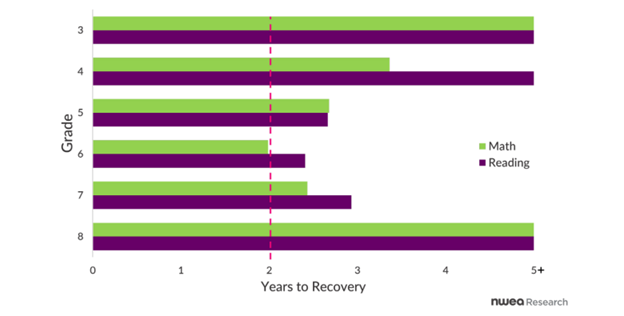Slightly older students in fifth, sixth and seventh grades, who were in second grade and above when the pandemic hit, are making much better progress in reading. If their current pace of learning continues, they’ll be on track to recover in two or three years, Lewis calculated. By contrast, it’s unclear when, if ever, current third graders will even catch up to pre-pandemic norms in reading. Lewis said there is a “long road to go” and that she estimates it will be “five plus years” for these third graders to catch up. That would be after eighth grade for this class of children. (See recovery graphic below.)
Estimated years to reach recovery by subject and grade

It’s worth noting that pre-pandemic reading levels weren’t spectacular and had been deteriorating; most children were not proficient in reading for their grade level, as measured by a national yardstick. So, it’s an estimated “long road” to return to a rather low level of achievement that was already a subject of consternation and hand-wringing.
The NWEA research brief, Progress towards pandemic recovery: Continued signs of rebounding achievement at the start of the 2022-23 school year, was released on Dec. 6, 2022. It analyzes scores on its Measures of Academic Progress (MAP) assessments that are purchased by more than 22,000 schools to measure student progress in both reading and math twice a year, in the fall and the spring. These are in addition to mandatory state assessments taken by students each spring.
This latest NWEA report describes how student achievement deteriorated in 2020 and hit a bottom in the spring of 2021, after which student learning stabilized – a sign that students were once again learning at a typical pace as schools reopened.
Though the report delves into both math and reading, I chose to focus on reading, a subject in which students didn’t fall as far behind during the pandemic, but are now making weaker catch-up progress. Interestingly, the report was able to detect that reading recovery among older students in grades four through seven isn’t happening at school. They’re learning at a typical pre-pandemic pace during the school year but avoiding some of the usual deterioration of reading skills during the summer. Typically, students forget a lot over the summer, a phenomenon known as “summer slide” or “summer learning loss.” It is unclear from this report why students retained more than usual during the summer of 2022 and returned to school in the fall with better-than-expected reading levels.
I was more concerned about the alarm bells for third graders and why they’re struggling so much more than older students in reading. Timothy Shanahan, a literacy expert and a professor emeritus at the University of Illinois at Chicago, said that younger elementary school kids rely on classroom instruction in school to learn to read. In older grades, much of the learning that accrues in reading is due to the students’ own reading and writing activity.
“Those [early] grades are particularly sensitive to educational disruptions,” Shanahan explained by email. “A fourth grader may have read for some number of minutes per day during those missed school days, while a kindergartner or first grader may not have been able to do that at all (since they wouldn’t know how yet).”
The early elementary years are critical because that’s when most children learn how to read words, what educators call “decoding.” Teachers in older grades don’t necessarily have the specialized training to backfill what students missed. A second grade teacher, for example, would likely not know much about teaching students how to identify and manipulate individual sounds in spoken words, an important step in learning to read called “phonemic awareness,” because it’s a skill that is the province of kindergarten and first grade teachers, Shanahan explained.
“I didn’t hear of lots of schools that were making explicit efforts to deal with that problem though certainly some individual teachers or schools might have,” said Shanahan.
Callie Lowenstein, a second grade teacher at a bilingual elementary school in New York City, said that teachers feel “pressure” to stay on track with grade level lessons that don’t “accommodate or plan for the kinds of gaps we’re seeing.”
“Many curricula include an extremely cursory review of previous skills — so students who didn’t master earlier grades’ content are just left in the dust,” Lowenstein said. For example, the second grade reading lessons she follows review the entire alphabet in one day and move quickly on. Many students need more practice.
Catlin Goodrow is a reading specialist who works with third, fourth and fifth grade students who need extra help at a charter school in Spokane, Washington. She said she is working daily with a small number of third graders on basic first grade phonics. In some cases their parents kept them out of school for a full two years. But most students aren’t this far behind.
More common are random gaps because children didn’t receive enough reinforcement or weren’t taught topics during quarantines. One child might not understand how a silent “e” at the end of a word affects pronunciation. Another child might not understand how to sound out words with “ough” in them.
“It’s not as simple as being a year behind,” Goodrow said. “That would maybe be easier. It’s that they each have these really specific things that they didn’t pick up on. They each missed crucial bits and pieces.” Discovering them and filling them in for each child isn’t easy.
Goodrow is hearing from third grade teachers that even children who can read words are having a much harder time paying attention to what they are reading than in previous years. Third graders are having greater trouble absorbing the meaning, identifying the main character or explaining what the story is about.
“The comprehension piece can be something they’re having challenges with,” said Goodrow. “I often think about, ‘Did they get those experiences where they were having their teacher read aloud to them and think aloud, and they’re on the carpet nearby?’ A lot of times, even when they were back at school full time, they were distanced. So they might not have had some of those early literacy experiences that built their ability to focus on the text that they’re reading.”
Because third grade is so critical, 16 states plus the District of Columbia require children to repeat the year if they cannot read at a basic level. Based on this NWEA test score report, states could be facing an avalanche of held-back children if those retention rules are enforced later this school year. That’s something I’ll be watching.


/cdn.vox-cdn.com/uploads/chorus_image/image/62810996/Amm_DeepSentinel_01.0.jpg)

More Stories
Make It A Movie Night with Walmart+
Teacher-led vs student-led lesson activities – David Didau
Links + Before + After Photos of My Brothers Bedroom Makeover!